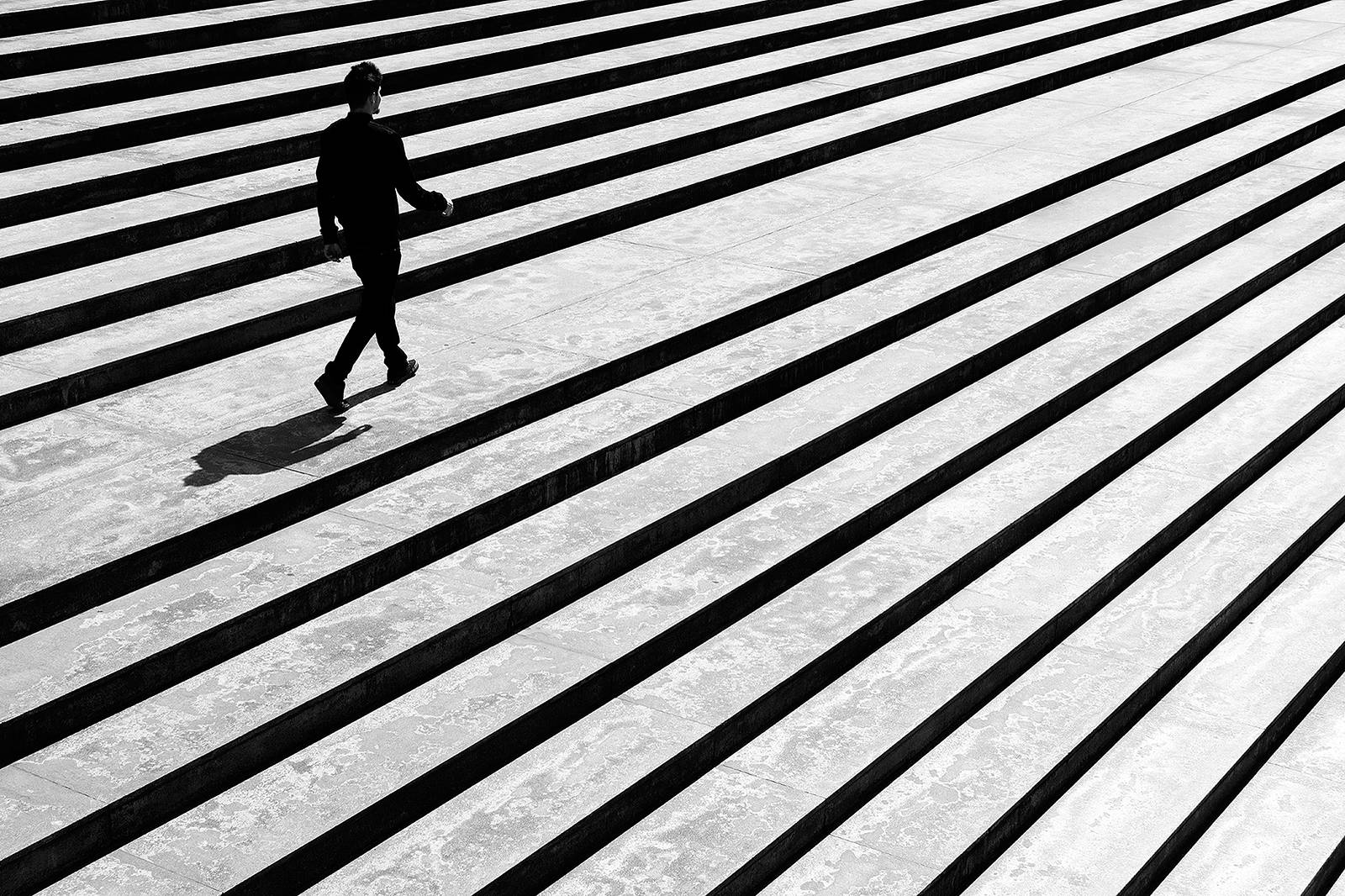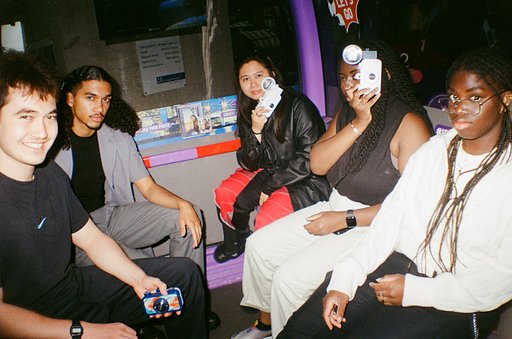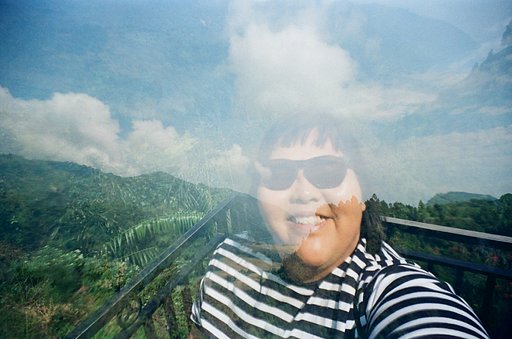A Geometrical Street Ballad of Black & White by Moisés Rodríguez
5 31 Share TweetMonochromatic, geometric, symmetric: to mix the different elements of aesthetics into the candid rules of street photography is a strict task to bear, much more to be consistent with it. However, Mexican street shooter Moisés Rodríguez’s oeuvre boasts these master qualities.
Read our interview with Moisés here in Lomography Magazine.

Hi Moises, thank you for having the time with us here in Lomography Magazine. First things first, we notice your photographs play a lot on shapes and geometry. Where do you usually look for those shapes and geometric composition?
Hi guys. First of all, thank you very much for the interview and the opportunity to contribute with some of my work to “Lomography Magazine”. Everything has a perfect relationship with geometry, is implicit in everything we see and develop; you can find it anywhere without necessarily doing a thorough search of it, one just needs to be observant of their environment.
To the extent that observation occurs, you realize that everything in your surrounding, on a general level or in some structural peculiarity is visually harmonious.
You also shoot in black and white. May you share with us why? And have you tried color?
I like the color but it is something that we all see from sunrise to sunset, every day, all year. Who has had a dream where everything is involved in Black and White? I would dare to say that no one, for the simple reason that we dream as we see. On the contrary, Black and White is unnatural, is a moment unable to happen in life and is its inability which fascinates me. To sum up, color is already created; Black and White have to be created.
I have experimented with color and I got some color photography as well, but most of the time I preview the situations in monochrome and before pressing the shutter release I have already determined the result I want to get. Although I have to say that there are times when things go completely backward and what I had thought as a picture without color, at the end is better with it.
Apart from the geometric elements present in your oeuvre, what else are the elements you always look for when composing an image?
Well, it involves many other things that I’m also crazy about. The negative space, backlight and high contrast, human presence and abuse in cleaning the image are ingredients that I like to consider as well.
The geometry and/or symmetry are visually stunning elements but alone its narrative is poor. It is the combination of several of these ingredients when, for me, an image comes to power and turns from a stream to a runaway river that can trigger the viewer’s imagination.
You have a unique style of street photography. Personally, what does street photography mean to you?
For me, street photography means uncertainty and anecdotes. When I take my camera and go out, I have the certainty that something is waiting for me, I do not know what but I do know that there is no coincidence, so from the time I decide to go to take a photograph I am determined to the encounter with some unknown who, with its walk through the city, will tell me a story. What would become of what we love if we wouldn’t imagine our own stories with it?
Do you have certain art principles do you follow?
To be honest my knowledge on the principles of art are scarce, but as a social communications graduate specializing in the aesthetics of public spaces I would like to mention something that has to do with a single principle that I try to follow and seek to represent in my pictures: there is currently an aesthetic urban crisis referring to the common spaces by the predominance of the quantitative over the qualitative. Cities such as Mexico are overcrowded by urban developments that barely cover the functionality standard without harmony with each other and, therefore, with no pleasure to the senses.
To not more than what is due from the foregoing that, as far as possible, I seek the cleanliness in the image and the harmonious integration of the citizen with a small portion of its environment. This is nothing other than the familiar phrase, “Less is more”.
What or who are your creative muses?
I consider “light” as my biggest inspiration; even before I got into photography I rarely paid attention to the impact of the same on all objects. Today is my muse and ally; it is amazing how the shadows of absolutely everything are projected in line with the position of the sun and how depending on the time of day one can get several photographs completely different from the same place.
This is nothing new for any photography buff neither I’m discovering nothing new of the matter, but I could not fail to mention that my creative muse is nothing but the basis of photography itself.
If you have any, who’s your favorite street photographer?
It would not be on this ship if I had not fallen in love with other street images in black and white and certainly I could mention several photographers who have my full admiration, but I will stick to the question and only mention one of them… Gabriele Croppi and her city raising itself with huge amounts of black over the inhabitants bathed in sunlight fascinates me. Her photograph moves me to a world ruled by loneliness and longing and to see her pictures, again and again, it is an incentive to continue on this path. It is poetry to my eyes.
What’s the hardest part you face whenever you’re working in photography?
There are two challenges that I face when I go out to take pictures. The first is the number of people in the city where I live; we are about nine million citizens in a demographically small area and this is reflected in the streets. Most of the time I desire a person per frame and that translates into long waits.
The second is a ban on taking photographs in many places for safety. There is a pervasive culture of fear and its thought that everyone who carries a camera is a potential criminal. To mention an example, I was recently kicked out of a museum where it is completely allowed to take photos, however to the Safety inspector on duty it seemed suspicious that I was standing with my camera in hand, in the same place for more than an hour.
It is sad to see such an enriching activity as photography suffers from a widespread bias shielded under a prevention policy and unfortunately, in the city where I live it is like this.
It is said that every photographer has that ‘decisive moment’. Have you gotten yours? If so, which instance/photograph was that?
If we are talking about a single image: I am very fond of my photograph “Pst, Pst!” due to the spontaneity of the circumstance and the woman’s look at noticing the camera, although I do not think it’s my " defining moment". I would even think that every photographer, through perseverance, learning and overcoming their own work, can have several such episodes during their adventure in photography.
Lastly, what’s next for you? Do you have any plans in branching out your style? Or are you still trying to furnish your photographic signature?
Yes, I have other plans, but sometimes I’m very slow and tend to procrastinate to carry them out.
I invest part of my spare time reading and, as in any hobby, I have my favorite authors and certain stories burned into my mind, so the next step I would love to take in photography is the union or representation of certain literary passages through the image in Black and White. I think that the works of Edgar Allan Poe, H. P. Lovecraft, Charles Dickens, Guy de Maupassant and Ambrose Bierce (among others), open a huge portal of possibilities to play with light and the characterization of some of their characters and, in that sense, I would also like to make a small reinterpretation / photographic tribute of two television series that, for me, are fantastic: “The X-Files” and “The Twilight Zone”. With the above, I do not mean that I will change my photographic style, but I like to try new things and what better if by combining two of my passions.
Broadly speaking, that’s me and my world of minimalist urban scenes to the pace of the absence of color.
If you’ve enjoyed our conversation with Moisés, read our feature article or drop by his portfolio, Instagram and Facebook for more of his works. All images used are with permission from Moisés Rodríguez.
written by Ciel Hernandez on 2016-08-21 #people #black-and-white #geometry #street-photography #symmetry #street-photographer #urban-photography #moises-rodriguez





































5 Comments